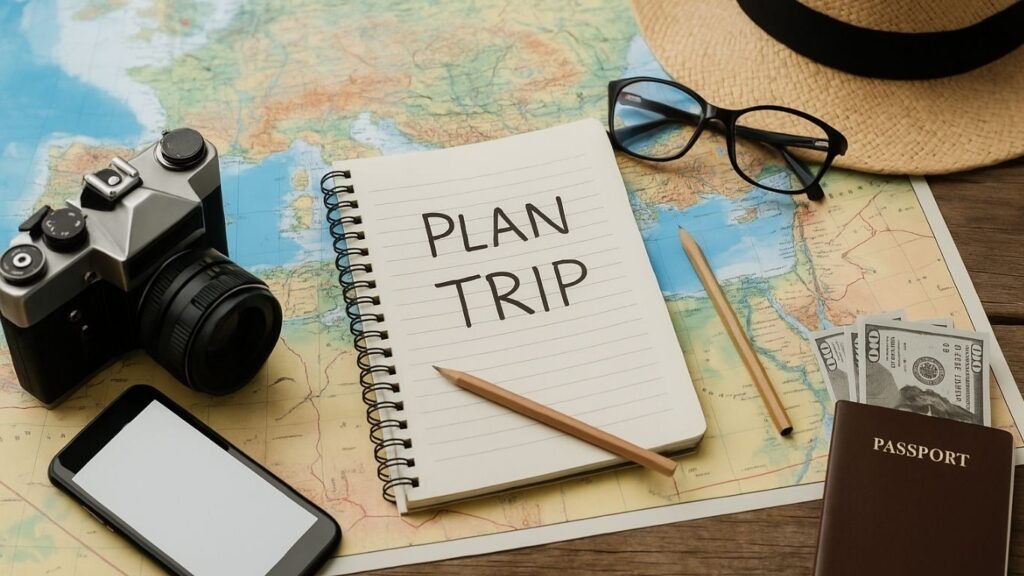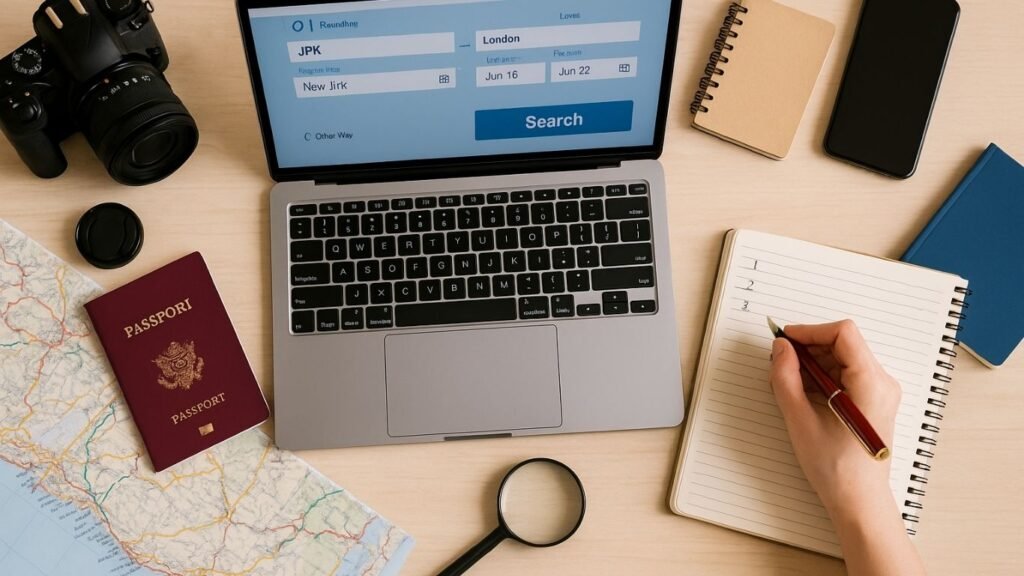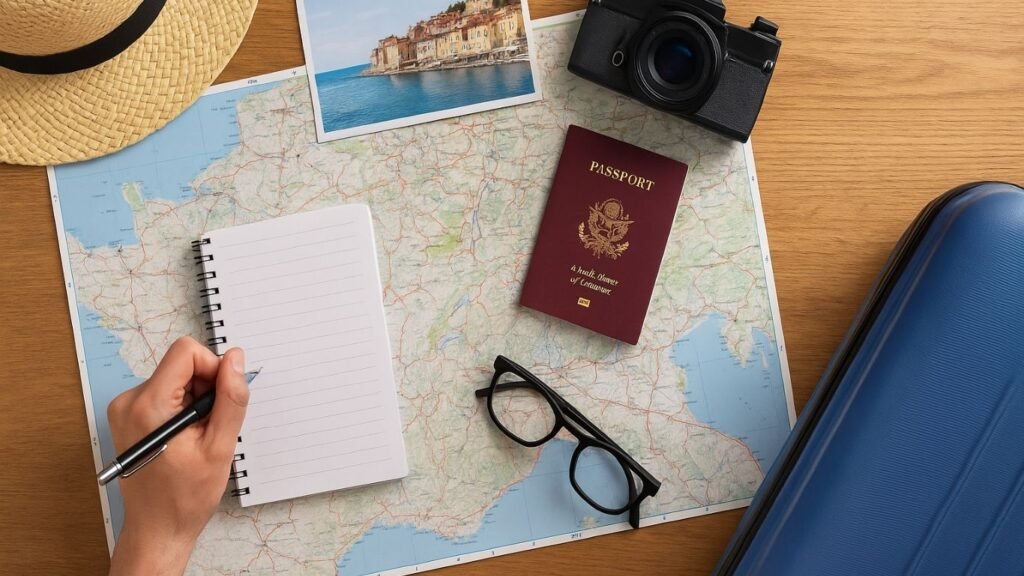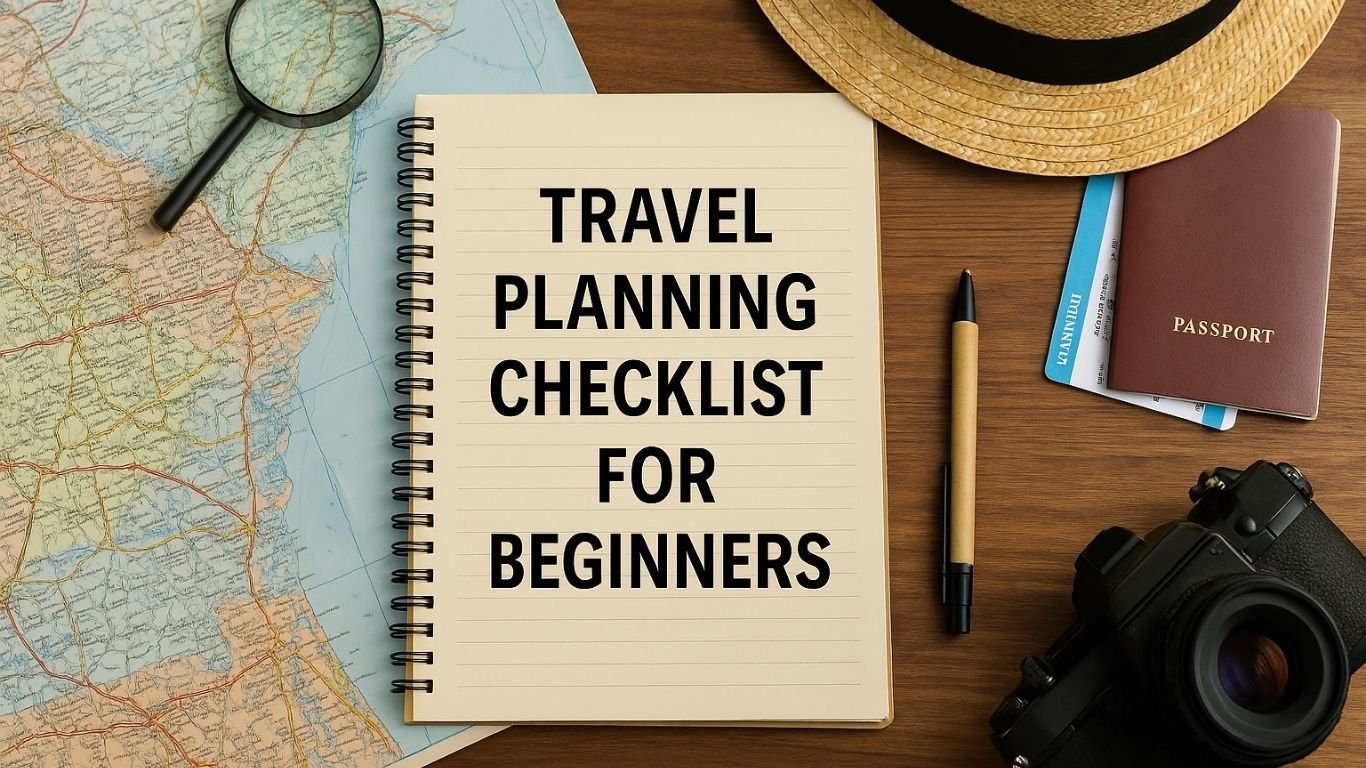Planning your first trip can feel overwhelming—there’s so much to think about before you even pack your bags. From booking flights to organizing documents, small mistakes can lead to big headaches. That’s why having a structured travel planning checklist for beginners is essential.
This guide breaks down the 17 most important steps to take before you board that plane—ensuring nothing gets overlooked and you can travel with confidence.
Table of Contents
1. Define Your Destination and Travel Style

Before you dive into logistics, start with the foundation: where you’re going—and how you want to experience it. This might seem obvious, but the clearer you are about your travel goals, the smoother your entire trip will be. This step isn’t just about picking a country or city. It’s about aligning your destination with your interests, comfort level, and the kind of experience you want to create.
Are you dreaming of sun-drenched beaches, bustling urban centers, remote hiking trails, or ancient ruins? Your travel style influences not just your destination, but your pace, packing strategy, accommodation preferences, and even budget.
If you’re a first-time traveler, opt for destinations known for being beginner-friendly. Think Portugal over Peru, or Thailand over Turkmenistan. Consider factors like language barriers, safety, ease of transportation, and how tourist-friendly the location is. Use online forums like Tripadvisor or travel blogs to get a sense of what others are saying about traveling in those places.
It’s also worth considering travel seasons. Do you prefer exploring cities in cooler shoulder months, or basking in tropical heat during peak season? Timing can influence your itinerary, flight prices, and accommodation availability—so let that guide your decision, too.
Once you’ve locked in your destination and travel style, the rest of your travel planning checklist for beginners will start falling into place with far more ease.
Pro Tip: Create a mood board on Pinterest or save Instagram posts that reflect your ideal travel vibe. It helps visualize your goals and builds excitement as you plan.
2. Set Your Budget
Budgeting isn’t the most glamorous part of trip planning, but it’s absolutely foundational. Think of your budget as the invisible compass guiding every decision that follows—from flights and hotels to daily meals and spontaneous adventures. For beginners, setting a realistic travel budget is one of the most empowering steps in any travel planning checklist for beginners.
Start by determining how much you’re comfortable spending overall. Then, break it down into categories: transportation, accommodation, food, activities, travel insurance, and a buffer for unexpected costs. Don’t forget essentials like visa fees, vaccinations, or airport transfers.
Use tools like Budget Your Trip to research average daily costs in your destination. It’s especially useful for comparing budget travel in cities like Budapest versus more expensive locales like Paris or Tokyo. For flights, Google Flights and Skyscanner can help track deals that align with your target price.
One often overlooked part of budgeting is setting priorities. Are you the kind of traveler who’s happy with budget hostels but won’t compromise on gourmet food? Or maybe you’re all about convenience and comfort, even if it means fewer activities. Knowing your values will help you make choices that feel good rather than restrictive.
A smart budget gives you freedom, not limitations. It helps you travel with confidence, knowing that your finances are supporting—not sabotaging—your experience. And for any travel planning checklist for beginners, that peace of mind is invaluable.
Pro Tip: Build in a daily “fun fund” for spontaneous expenses like street food, local experiences, or unplanned souvenirs.
3. Choose Your Travel Dates
Choosing your travel dates is more strategic than just picking days off from work. The time of year you travel can significantly affect your experience—from weather and prices to local events and tourist crowds. This step is a pivotal part of any well-organized travel planning checklist for beginners because it helps you balance cost, comfort, and availability.
Start by researching your destination’s seasons. High season typically means great weather but also higher prices and more crowds. Shoulder seasons (the period just before or after peak times) are often ideal—they offer pleasant weather, thinner crowds, and better value. For example, visiting Italy in May or September gives you the charm of summer without the intensity of July’s heat or the August tourist influx.
Also consider local festivals or holidays. These can either enhance your trip—like experiencing Diwali in India or Carnival in Brazil—or complicate logistics with sold-out accommodations and transportation. Sites like Time and Date or local tourism boards can help you track regional calendars.
Flexibility can be a money-saver, too. If your schedule allows, use fare comparison tools to find the cheapest days to fly. Flying midweek is often less expensive than weekends, and early morning or red-eye flights can offer even deeper discounts.
Ultimately, choosing your dates isn’t just about availability—it’s about crafting the kind of experience you want. Locking in the right time to travel makes every other item on your travel planning checklist for beginners more seamless.
Pro Tip: Create a simple spreadsheet comparing your top 2–3 timeframes, including weather, cost, and event calendars, to make a well-rounded decision.
4. Book Flights and Accommodation

With your destination and dates set, it’s time to lock in two of the biggest anchors of your travel experience: flights and where you’ll sleep. Booking these early not only saves money but also offers peace of mind, making this a crucial milestone in your travel planning checklist for beginners.
Flights First: Know When to Book
Airfare can fluctuate wildly, especially if you’re flying internationally or around holidays. Studies from Hopper and CheapAir suggest that the best time to book domestic flights is about 1–3 months in advance, while international fares are often cheapest 2–8 months out.
Use tools like Google Flights, Kayak, and Skyscanner to compare fares across multiple dates and airlines. Set up price alerts and use the “flexible dates” feature to spot cheaper alternatives.
Don’t just focus on price—pay attention to layovers, total travel time, and cancellation policies. Budget airlines may save you money upfront but can come with hidden fees for bags or seat selection.
Accommodation: Prioritize Location and Reviews
When booking a place to stay, consider your travel style and comfort level. First-time travelers often gravitate toward mid-range hotels or highly rated hostels, but short-term rentals like Airbnb or Booking.com properties offer local flair and flexibility. Always read recent reviews, check for amenities, and look at maps to ensure your accommodation is conveniently located near public transport, attractions, or walkable neighborhoods.
If you’re unsure about committing, some platforms offer flexible bookings that allow cancellations closer to your travel date—a nice safety net for anyone working through a detailed travel planning checklist for beginners.
Pro Tip: Filter reviews for solo travelers or couples (depending on your situation) to see if others with similar needs had a good experience.
5. Research Visa and Passport Requirements
Before you can board any international flight, your documents must be in order. Overlooking visa and passport requirements is one of the most common mistakes first-time travelers make—yet it’s one of the most important parts of any smart travel planning checklist for beginners.
Check Your Passport Expiry First
Many countries require your passport to be valid for at least six months beyond your entry date. If yours is expiring soon, renew it now. Processing times can vary by country, and during peak seasons, delays are common. Use your country’s official passport services website to check timelines, fees, and application steps.
Know the Visa Rules—They Vary Widely
Visa requirements differ not just by destination, but also by the type and length of your visit. Some countries allow visa-free entry for short tourist stays, while others require a visa on arrival or pre-approval through an online application (eVisas). For instance, U.S. travelers can enter most of Europe’s Schengen Area without a visa for up to 90 days, while trips to Vietnam or India require advance applications.
Use reliable sources like your government’s travel advisory page or tools like iVisa to find up-to-date entry requirements.
Don’t forget about transit visas, either—if your layover involves switching airports or passing through immigration, you may need one even if you’re not staying in the country.
Document Everything
Once your visa is approved (if applicable), print and save digital copies. Bring a backup with you in case your phone dies or you lose access to email. This level of preparedness reflects the kind of foresight that sets a solid foundation in a travel planning checklist for beginners.
Pro Tip: If you’re traveling to multiple countries, double-check that your passport has enough blank pages for entry and exit stamps.
6. Get Travel Insurance
If there’s one thing seasoned travelers agree on, it’s this: never travel without insurance. It’s not just a backup plan—it’s a necessity, especially for first-time adventurers. Medical emergencies, trip cancellations, lost luggage, or even a missed connection can cost thousands without proper coverage. That’s why getting travel insurance should never be overlooked in any well-rounded travel planning checklist for beginners.
Why Travel Insurance Matters
Healthcare systems abroad vary greatly, and even a simple hospital visit can cost more than your entire trip. Travel insurance can cover emergency medical expenses, medical evacuation, and repatriation. In more serious cases, this coverage is not just helpful—it can be life-saving.
But it goes beyond health. Lost baggage, delayed flights, natural disasters, or even civil unrest can derail your plans. A comprehensive policy reimburses you for prepaid costs and gets you back on track.
What to Look For
Not all policies are equal. Look for plans that include:
- Emergency medical coverage (especially if your destination lacks public health infrastructure)
- Trip cancellation and interruption
- Lost, stolen, or delayed baggage
- Emergency evacuation
- COVID-19 coverage (many providers now include this)
Providers like World Nomads, SafetyWing, and Allianz Travel offer tailored plans for travelers, including those planning long-term or multi-destination trips.
Before purchasing, compare policies based on coverage limits, exclusions, and deductibles. Some credit cards offer limited travel insurance if you use them to book your trip—but these often aren’t enough on their own.
Stay Covered, Stay Confident
Getting insured isn’t just a box to tick. It gives you the confidence to enjoy your journey, knowing you’re protected if things go sideways. That’s exactly the kind of peace of mind a travel planning checklist for beginners is designed to offer.
Pro Tip: Print out your insurance card and keep a digital copy easily accessible. Also, save the emergency contact number for your insurance provider in your phone.
7. Plan Your Itinerary (Loosely)
An itinerary isn’t meant to be a rigid script—it’s your roadmap to discovery. Especially for first-time travelers, having a flexible plan allows you to get the most out of your trip without feeling overwhelmed. In fact, building a loose itinerary is one of the most empowering tools in any effective travel planning checklist for beginners.
Start with the Big Blocks
Anchor your itinerary with major experiences: museum visits, tours, hikes, day trips, or special events. These often require reservations, so book them in advance and sprinkle them evenly across your stay. Avoid packing too many high-energy activities back-to-back. Instead, mix adventure days with slower-paced ones to avoid burnout.
Research the average time needed for each activity. A castle tour may take 2–3 hours, but if it’s on a hilltop an hour outside the city, your day could easily fill up. Planning around reality rather than assumptions ensures smoother transitions and more enjoyment.
Balance Planning and Spontaneity
Leave breathing room for surprises. Maybe you’ll stumble upon a street fair, meet locals who invite you somewhere off the map, or decide to linger longer at a sunset viewpoint. Over-planning every minute can make travel feel like a chore.
That said, even a loose itinerary should factor in logistics—like how long it takes to get from your hotel to a train station, or whether your day trip ends late enough to require dinner reservations nearby.
Use Tools to Stay Organized
Apps like Google Maps (with pinned locations), Rome2Rio for transport, and Wanderlog for itinerary planning can keep you organized without making your trip feel scripted. Syncing everything to your calendar or travel folder ensures you won’t be scrambling last-minute.
Having a structured-yet-flexible itinerary provides clarity without boxing you in. It’s an essential habit to build as part of any thoughtful travel planning checklist for beginners.
Pro Tip: Leave the last full day of your trip light. You’ll appreciate the time to rest, reflect, or squeeze in anything you missed.
8. Pack Smart
Packing is both an art and a science. It’s where preparation meets personal style, and for first-time travelers, it can also be one of the most intimidating steps. Packing smart means more than just fitting everything into a bag—it’s about bringing what you need and leaving what you don’t. Mastering this balance is an essential element of any well-designed travel planning checklist for beginners.
Know the Basics: Weather, Culture, and Activities
Start with research. What’s the climate like during your visit? Are there cultural norms to be mindful of—like modest dress in religious areas or removing shoes indoors? Will you be hiking, swimming, dining at upscale restaurants, or wandering through cobblestone streets? Your wardrobe should serve your itinerary, not the other way around.
Create a list of essentials: a few versatile outfits, walking shoes, lightweight layers, and accessories like a compact umbrella or scarf. Focus on mix-and-match items that roll up easily and dry fast.
Less Is Almost Always More
First-time travelers often overpack. But dragging a heavy suitcase up narrow staircases or through metro stations is a quick lesson in regret. Stick to the 80/20 rule: you’ll wear 20% of your clothes 80% of the time. Instead of packing for every possible scenario, pack for your actual trip—with one or two “just in case” items.
Invest in packing cubes to stay organized and compress space. Keep essentials like travel documents, electronics, chargers, and a change of clothes in your carry-on.
Don’t Forget These Travel-Smart Extras
- A universal adapter and power bank
- Reusable water bottle
- Travel-size toiletries (TSA compliant)
- A small laundry bag for dirty clothes
- Ziplock bags for liquids or snacks
Smart packing eliminates unnecessary stress and helps you move through your journey with comfort and efficiency. That’s why it’s one of the most practical steps in any travel planning checklist for beginners.
Pro Tip: Lay everything out before you pack. If you haven’t used or worn it in six months, you probably won’t need it now.
9. Arrange Transportation at Your Destination

You’ve landed—but how will you get around once you’re there? Whether you’re navigating a metro system, hailing a tuk-tuk, or renting a car, having a transportation strategy is a vital step in any travel planning checklist for beginners.
Start with Arrival Logistics
Before your plane touches down, know how you’ll get from the airport to your accommodation. Major cities often offer multiple options: airport shuttles, trains, buses, rideshares, or taxis. Each comes with its own price point and convenience level. Check airport websites or platforms like Rome2Rio for clear, updated transit routes.
Pro tip: If arriving late at night or in a country where scams are common, pre-book a taxi or arrange a pickup through your hotel.
Public Transit vs. Ride Shares vs. Rentals
For urban destinations, public transportation is usually the most cost-effective and efficient way to move around. Learn how to use the local metro, tram, or bus system in advance. Many cities offer unlimited day passes or reloadable transit cards.
Apps like Moovit, Google Maps (with transit mode), and Citymapper are invaluable tools for real-time route planning and schedule updates.
In places where public transit is limited or unreliable, ride-hailing apps like Uber, Lyft, Grab, or Bolt can save time and stress. Just be mindful of surge pricing and local app alternatives.
For rural destinations, road trips, or off-the-beaten-path exploring, a rental car might make sense. Make sure your driver’s license is valid abroad—some countries require an International Driving Permit (IDP).
Transportation = Freedom (When Done Right)
When arranged thoughtfully, transportation becomes an enabler, not an obstacle. It lets you explore with ease, stay safe, and enjoy more of what your destination has to offer. That’s why sorting out your ground travel is a must-do item in any detailed travel planning checklist for beginners.
Pro Tip: Download offline maps and save key locations before you arrive. You never know when you’ll be without Wi-Fi or mobile data.
10. Inform Your Bank and Credit Card Companies

Few things derail a trip faster than having your card declined abroad. It’s a common oversight—but one that’s easily avoidable. Notifying your bank and credit card providers of your travel dates and destinations is a key, often overlooked item on any smart travel planning checklist for beginners.
Why This Step Matters
Banks and financial institutions are on high alert for fraud. If they detect a charge coming from a foreign country that doesn’t match your usual spending pattern, they may freeze your account or block the transaction. While it’s done to protect you, it can be incredibly inconvenient when you’re trying to check into a hotel or pay for dinner overseas.
Many banks allow you to set a travel notice through their mobile apps or websites. It takes just a few minutes and can save you from major frustration later on.
Know Your Fees and Limits
While you’re updating your travel status, check whether your card charges foreign transaction fees—typically 1–3% per purchase. Consider switching to a travel-friendly credit card that waives these charges, like the Chase Sapphire Preferred or Capital One Venture.
Also, be aware of ATM withdrawal limits and conversion fees. Some banks partner with international networks to offer fee-free withdrawals—take note of these if available. And always opt to be charged in the local currency to avoid dynamic currency conversion markups.
Backups and Safety Nets
Carry at least two cards—ideally from different providers—and keep them in separate places in case one is lost or stolen. You might also want to bring a small amount of emergency cash, especially in countries where card use is limited.
Planning for financial access isn’t just smart—it gives you peace of mind and flexibility. That’s why it belongs in every responsible travel planning checklist for beginners.
Pro Tip: Save your bank’s international customer service number and card cancellation hotline in your phone and written down in your travel folder.
11. Set Up Phone and Data Plans
Staying connected while abroad isn’t just about sharing your travel highlights on Instagram—it’s about navigating unfamiliar places, contacting emergency services, confirming reservations, and translating signs or menus. That’s why setting up a reliable phone and data plan is a non-negotiable part of any well-structured travel planning checklist for beginners.
Check with Your Provider
Start by contacting your current mobile carrier. Many providers offer international roaming plans, but they can be pricey or limited in coverage. Review the daily rates, data caps, and supported countries. If the plan seems too restrictive or expensive, consider alternatives.
Consider an International eSIM or Local SIM
An increasingly popular option is using an eSIM—a digital SIM card you can install remotely before or upon arrival. Services like Airalo and Holafly offer affordable data packages across hundreds of countries, allowing you to stay online as soon as you land.
Alternatively, buying a local SIM card once you arrive often gives you the best rates. Just make sure your phone is unlocked. You’ll usually find SIM cards at airports, mobile shops, or convenience stores. Look for packages that include calls, texts, and at least a few GBs of data.
Download Essentials While You’re Still on Wi-Fi
Before departure, download offline maps (Google Maps), translation tools (Google Translate), ride-hailing apps, your digital boarding passes, and any travel documents. A little prep goes a long way in reducing data usage and dependence on constant connectivity.
Reliable communication gives you flexibility, freedom, and safety—core elements of any strong travel planning checklist for beginners. Whether you’re calling your hotel for check-in or navigating a confusing metro system, having a working phone is not a luxury—it’s a lifeline.
Pro Tip: Bring a portable charger or power bank. Few things are more frustrating than running out of battery when you need your phone the most.
12. Make Copies of Important Documents
Losing your passport, missing a visa, or being unable to access critical travel documents can instantly turn a dream trip into a logistical nightmare. That’s why making both physical and digital copies of your most important documents is a smart and essential part of any travel planning checklist for beginners.
Which Documents to Copy?
At minimum, you should make copies of:
- Your passport’s ID page
- Visas (if applicable)
- Travel insurance details
- Flight and hotel confirmations
- Credit and debit cards (front and back)
- Driver’s license or international driving permit
- Emergency contact list
- Vaccination certificates (especially if required for entry)
Keep one printed set in a separate part of your luggage from the originals—ideally in your carry-on or daypack. This ensures you’re never left completely helpless if your bag goes missing or your wallet is stolen.
Create Digital Backups
Scan your documents or take high-quality photos and store them in a secure cloud service like Google Drive, Dropbox, or iCloud. Also save them on your phone for offline access, and consider emailing copies to yourself or a trusted family member.
Be sure to protect your files with strong passwords and two-factor authentication, especially if you’re storing sensitive personal or financial information.
Why This Matters for First-Time Travelers
In unfamiliar environments, having backup documentation can streamline everything from checking into a hotel to replacing a lost passport at the consulate. It reduces panic, saves time, and gives you a level of control that’s essential when navigating the unknown—all reasons this step holds a firm place in any comprehensive travel planning checklist for beginners.
Pro Tip: Write down your passport number, expiration date, and the address of your home country’s embassy or consulate in your destination country.
13. Download Useful Apps
In today’s digital age, your smartphone is more than just a camera or messaging device—it’s your map, translator, guidebook, and emergency assistant all in one. That’s why downloading the right travel apps before departure is a must in any thoughtfully prepared travel planning checklist for beginners.
Essential Apps to Install Before You Go
- Google Maps – Download offline maps of your destination so you’re never stranded without directions.
- Google Translate – Instantly translate signs, menus, or conversations with real-time camera and voice features.
- Currency Converter – Apps like XE or Currency let you convert prices instantly and avoid overpaying.
- Transportation Apps – Citymapper, Moovit, or local metro apps help you master public transit.
- Accommodation & Booking Apps – Airbnb, Booking.com, Hostelworld, and Agoda let you manage reservations or book on the fly.
- Flight Trackers – Apps like FlightAware or TripIt keep all your travel info organized and updated in real time.
- Language Learning Tools – Duolingo or Babbel can help you pick up useful phrases and better connect with locals.
Apps for Safety and Convenience
- VPN (Virtual Private Network) – A secure VPN like NordVPN or ExpressVPN protects your data on public Wi-Fi.
- WhatsApp or Signal – These encrypted messaging apps are widely used worldwide and help you stay in touch.
- Airline & Bank Apps – Access boarding passes, update seat selections, and track expenses securely.
By downloading these tools ahead of time—especially those that work offline—you can avoid hiccups and make your travel smoother, safer, and more enjoyable. It’s a proactive move that earns its place in every efficient travel planning checklist for beginners.
Pro Tip: Organize your travel apps into a dedicated folder on your phone’s home screen. It saves time when you need quick access during a chaotic transit moment.
14. Pack Essential Medications and First-Aid Supplies

No one expects to get sick or injured while traveling, but it happens more often than you’d think. From unfamiliar foods and climates to long travel days and accidental scrapes, being prepared with a basic health kit is a crucial part of any reliable travel planning checklist for beginners.
Start with Your Personal Medications
If you take prescription medications, make sure to pack enough for your entire trip—plus a few extra days in case of delays. Bring them in their original packaging, along with a copy of your prescription or a doctor’s note. This is particularly important when traveling internationally, as some medications that are common at home may be restricted or illegal in other countries.
Carry medications in your hand luggage to avoid any risk of separation due to lost baggage. Always check import regulations for medications at your destination through embassy websites or official customs resources.
What to Include in a Travel First-Aid Kit
Even if you’re not prone to illness, these essentials can save you time, money, and discomfort:
- Pain relievers (ibuprofen or paracetamol)
- Anti-diarrheal and rehydration tablets
- Antihistamines for allergies or bug bites
- Band-aids, antiseptic wipes, and antibiotic ointment
- Motion sickness pills (especially for boat rides or long drives)
- Insect repellent and sunscreen
- Tweezers and safety scissors (packed in checked luggage)
If you’re traveling to remote areas or places with limited healthcare access, consider packing additional items like a thermometer, sterile gauze, and water purification tablets.
Health Preparation = Travel Confidence
Staying healthy on the road isn’t just about avoiding inconvenience—it’s about preserving your ability to fully enjoy the journey. That’s why including medications and first-aid essentials is a foundational move in any smart travel planning checklist for beginners.
Pro Tip: If you have specific medical conditions, consider wearing a medical alert bracelet or card and translating critical health information into the local language.
15. Notify Someone of Your Travel Plans
When you’re caught up in the excitement of planning a trip, it’s easy to forget how important it is to let someone back home know where you’ll be. Whether you’re traveling solo or with friends, keeping a trusted person informed of your itinerary is a fundamental part of any responsible travel planning checklist for beginners.
Who Should You Inform?
Choose someone you trust—ideally a close family member or friend who is easy to reach. Let them know your basic travel details:
- Flight numbers and departure/arrival times
- Hotel addresses and check-in dates
- Cities and countries you’ll visit
- Emergency contact information at your destination
- A copy of your passport and insurance info
You don’t need to give them a minute-by-minute rundown, but a simple itinerary with dates and backup contact methods will suffice.
Why This Step Matters
In case of emergencies—natural disasters, lost contact, or a sudden need to reach you—it helps to have someone who knows your whereabouts. If you lose your phone, get stuck in transit, or fall ill, having someone back home aware of your movements could be life-saving.
Apps like TripIt and Google Calendar let you share your travel plans digitally and update them in real-time. You can even share your live location temporarily through WhatsApp or Apple’s Find My.
Stay in Touch Periodically
You don’t need to send daily updates, but checking in every few days is a good habit—especially if you’re changing cities frequently. It’s one more layer of security that helps you travel with confidence and peace of mind, two things every travel planning checklist for beginners should prioritize.
Pro Tip: Establish a check-in schedule ahead of time so no one panics if you go offline briefly in a remote area or on a long travel day.
16. Exchange Currency

Money may not be the most romantic part of travel, but it certainly keeps the adventure moving. Whether you’re browsing local markets or grabbing a cab from the airport, having the right currency in hand is more than convenient—it’s essential. That’s why exchanging money should absolutely feature in any thorough travel planning checklist for beginners.
When to Exchange Money
Many beginners wonder: should I exchange currency before I leave or once I arrive? The answer is: a bit of both.
It’s smart to carry a small amount of local currency—just enough to cover your first day’s expenses like transportation, snacks, and tips. You can usually get a better rate at your destination, but not at the airport. Airport kiosks are known for poor exchange rates and hidden fees.
Instead, wait until you’re in the city and use a reputable exchange bureau or withdraw directly from an ATM. ATMs tend to offer better rates, especially if your bank has international partnerships.
Avoiding Unnecessary Fees
Before your trip, ask your bank:
- What are the foreign transaction and ATM withdrawal fees?
- Do they have global partners that offer fee-free withdrawals?
- Will your card work internationally?
And remember: always decline the offer to be charged in your home currency (called Dynamic Currency Conversion). It usually comes with unfavorable exchange rates.
Cash vs. Card: What’s the Right Balance?
In many countries, credit and debit cards are widely accepted. But cash is still king in others—especially for street vendors, transportation, or tips. Keep a reasonable amount of cash on hand, and store it in different places for security.
Making sure your money is both accessible and secure is one of the smartest things you can do—and it absolutely belongs on a complete travel planning checklist for beginners.
Pro Tip: Use a travel wallet or money belt to keep your cash, cards, and IDs safe and organized, especially in high-theft areas.
17. Confirm All Bookings Before You Go
You’ve researched, reserved, and prepared—but before you head to the airport, take one final (and crucial) step: confirm everything. This last-minute review is the finishing touch that ties your travel plans together—and a vital part of any foolproof travel planning checklist for beginners.
What Should You Double-Check?
At least 48 hours before departure, go through every reservation you’ve made:
- Flights: Check flight times, terminal information, and any gate changes. Confirm online and download your boarding passes.
- Accommodation: Reconfirm hotel or Airbnb check-in times, access instructions, and contact details.
- Tours & Activities: Revisit confirmation emails and calendar reminders. If tickets were emailed, download or print them in advance.
- Transportation: Double-check car rentals, train tickets, airport transfers, or local travel passes.
- Dining or Event Reservations: If you booked popular restaurants or tickets to shows, reconfirm your bookings.
If your itinerary spans multiple cities or countries, make sure everything is aligned—especially transport connections and check-in/check-out times.
Why It Matters
Mistakes happen—dates can be entered incorrectly, bookings can get lost, or providers may change schedules without notice. Confirming details not only helps you catch these issues early, it also reduces stress once you’re on the road.
It’s also a good time to gather all your essential confirmations into one place: a printed folder, an offline-access travel app like TripIt or Wanderlog, or a synced Google Drive. Having your documents accessible—even without Wi-Fi—can make all the difference.
A Confident Launch
This final sweep-through helps ensure your trip starts smoothly, with no last-minute hiccups. It’s the bow on top of your entire travel prep, and a fitting conclusion to a well-executed travel planning checklist for beginners.
Pro Tip: Set reminders on your phone for check-ins, airport transfers, or time-sensitive activities so nothing slips through the cracks.
How to Travel Better: A Beginner’s Guide to Sustainable Travel
